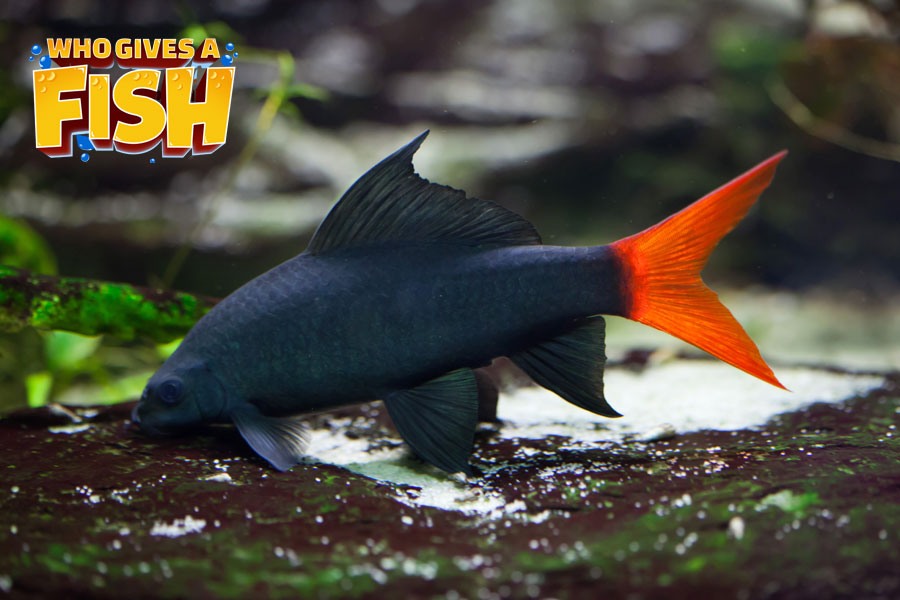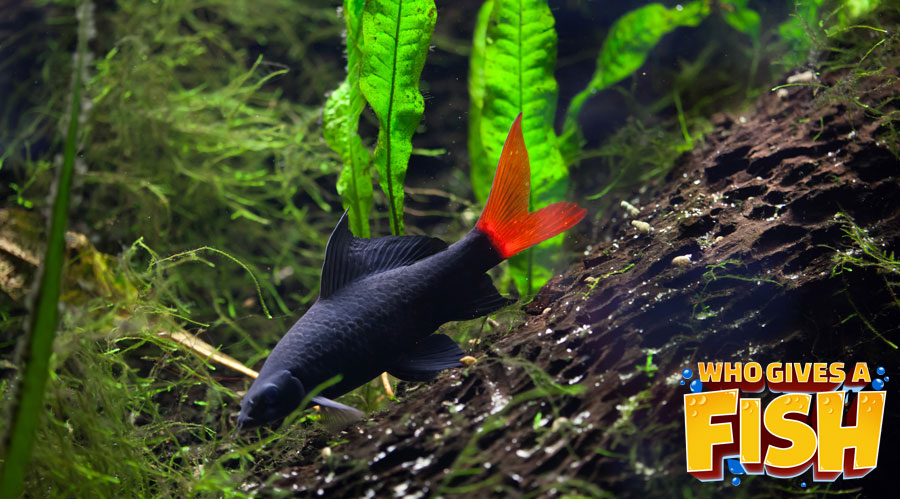Red Tail Shark
The Red Tail Shark, Epalzeorhynchus bicolor, belongs to the minnow and carp family Cyprinidae, and is a member of the genus Epalzeorhynchos. Labeo bicolor, used to be the scientific name for the red tail shark, but today it has been changed to Epalzeorhynchos (most commonly misspelled as Epalzeorhynchus).
Just like many other favored aquarium fish with “shark” in their name, the Red tail shark is not actually a shark. Accepted names for this particular fish include the redtail black shark, Redtail sharkminnow, Redtailed shark and the Red-tailed labeo.
- Experience Level: Beginner
- Hardiness: Hardy
- Minimum Tank Size: 55 G (208 L)
- Maximum Size: 6 in (15 cm)
- Temperament: Aggressive
- Temperature: 73°F – 79°F (23°C – 26°C)
- pH Range: 6.5 – 7.5
- Water Hardness: 10 – 16 dH
- Diet: Omnivore
Table of Contents
Introduction
Aquarium Setup
Feeding
Breeding and Social
The Red tail shark is favored in freshwater tropical aquariums. It is very alluring, with a brightly colored red tail that contrasts against its dark black body. The strength of the coloration can illustrate how well the this fish is doing in the aquarium, since a sick or stressed fish usually develop a more dull and lifeless coloration.
If you take good care for your Red tail , it can live up to 15 years.
Aquarium Setup
The Red tail shark can grow up to 12 centimeters in length, and should not be confined to an aquarium that is smaller than 3 feet (around 90 centimeters ). An aquarium that is well decorated, and furnished with plenty of rocks and plants will also be welcomed, as it closely resembles its indigenous home in Thailand. Artificial aquarium decorations and bogwwod can also be used to provide hiding spots.
They should ideally be kept in a closed aquarium, since it is known to jump. As this fish is indigenous to the tropics, the water temperature in the aquarium should be kept between 72-79 F (22-26 C) and the water should be fairly soft and the pH level 6.5 to 7.0.
Somewhat acidic water is better than neutral, however neutral water will be acceptable.
Red Tailed Shark Aquarium Guide
- Minimum Tank Size: 55 G (208 L)
- pH Range: 6.5 – 7.5
- Water Hardness: 10 – 16 dH
- Temperature: 73°F – 79°F (23°C – 26°C)
- Lighting: Low to Moderate
- Substrate: Any
- Water Flow: Low to moderate
- Tank Region: Primarily bottom but will swim in all areas
Red Tailed Sharks produce amazing contrasts with the greens of a Java Fern
Feeding
The Red tail is an omnivore that will eat crustaceans, plant matter, worms and insects in the wild. Combining meaty food with some algae, plant matter or vegetables is therefore a necessity. Most specimens will eat live food as well as pellets and flakes. As it is a bottom feeder with an under-turned mouth, pellets are more suitable than flakes.
Red Tail Shark Feeding Guide
- Diet: Omnivore
- Frequency: 2 – 3 times daily
- Pellet Foods: Yes
- Flake Foods: Yes
- Live Foods: Small snails, shrimp, worms and insects
- Meat Foods: Yes , as above with live foods
- Vegetable Foods: Yes, good algae and vegetable mixes
Breeding
Breeding the Red tail shark in aquariums is difficult, and as such, the Red tail sharks in fish stores have usually been imported from Thailand. In Thailand, generous amounts of Red tail sharks are produced in fish farms yearly. Only the occasional report of Red tail shark spawning in aquariums are known exist. One of the problems that must be overcome if you want to breed Red tail sharks is the fact that they are generally very combative. Keeping more than one Red tail shark in the same aquarium will generally result in a lot of fighting, and this is commonly an issue if you are intending to breed them. Determining gender can also be hard, however the females may have a less pointed dorsal fin.
The Red tail shark is local to Thailand, but it might already be abolished in the wild. Since it is favored in the aquarium trade, it is produced in aquacultures and tens of thousands of Red tail sharks are exported from Thailand yearly. Scientists are still not sure about the current status of the wild Red tail shark, or even why the wild population decreased so drastically. A lot people believe that the Red tail sharks popularity among aquarists has led to over-fishing, but there is no proof to support this.
Social
The fish is favored particularly in Asian biotope aquariums, as well as in conventional public tanks. It is very territorial, and keeping several Red tail sharks in the same aquarium will usually result in a lot of in-fighting. It can also be combative towards other species of fish, specifically if those particular species are comparable to this fish. Keeping it with other rugged fish that will not tolerate being bullied is recommended.
Keeping your Red tail with other fish from the same genus is usually not advised, and the Red-Finned shark and Siamese Algae Eater should also be avoided. Younger specimens are generally more placid than older fish. The Red tail shark has been successfully stored with big Barbs, Tetras and a variety of other rugged fish species.



